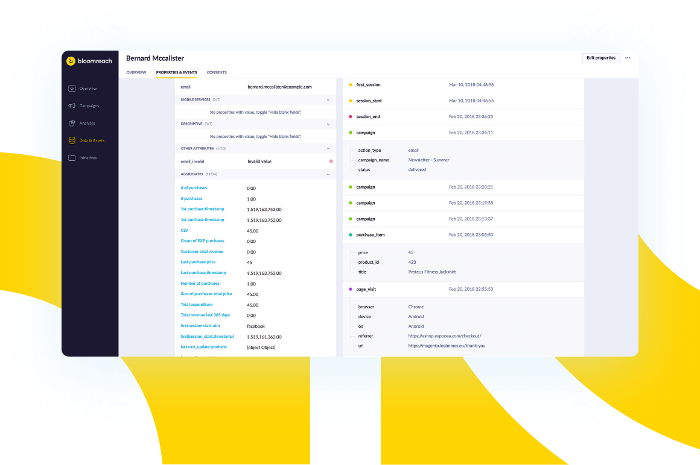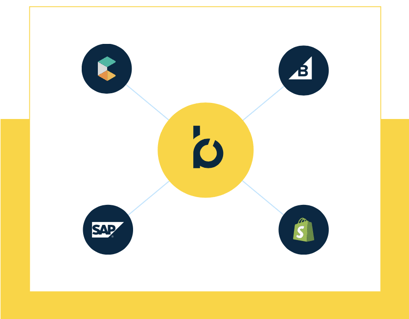A Guide to Digital Experience Platforms (DXPs)
And how they can transform your customer experience

Modern businesses need a solution that can drive end-to-end, personalized experiences that delight customers — all while scaling efficiency and agility.

The marketplace today is in transition. Digital has become the most effective way businesses not only find customers, but also engage with them. The quality of your digital experience means the difference between developing a long-term, profitable relationship with your customer and losing them to a competitor — and maybe never seeing them again.
Read on to discover:
The origins of DXPs and how they evolved
The critical components needed for a DXP to drive value
Why Bloomreach is the best DXP to unlock growth and future-proof your commerce strategy

In a hurry?
Download a PDF version for easier offline reading and sharing with coworkers.
Digitally-minded businesses need a modern, API-first solution that drives innovation and growth across the organization.
Bloomreach
Bloomreach defines a DXP as a combination of different capabilities (e.g. search and merchandising, marketing automation) from different domains (e.g. product discovery, engagement, content) coming together to enable a business to drive a dynamic, personalized, and relevant customer experience through their digital channels.

“It comes down to managing the experience. With web content management/CMS, it was all about building, launching, and changing a page. With DXPs, there is a paradigm shift: we’re now managing objects like content blocks and products, which are dynamically generated to ensure they are most relevant to the end customer that’s seeing it.
"It leverages real-time personalization and segmentation to make those decisions about what’s most relevant. The customer experience can be adapted in real-time based on how a customer is navigating and each page experience will be different for each customer -- with the priorities and controls a marketer or merchant needs to put in place. With web content management systems, it’s very prescriptive and difficult to scale.”
Brian Walker,
Chief Strategy Officer, Bloomreach
A Strong Foundation in Data
Scaling personalized, digital experiences requires a platform with a deep understanding of customers and products. At its core, a DXP must have a strong foundation in data.
Openness
A great DXP should offer the ability to connect to third-party systems so communication can flow between them. Openness also comes in the form of data being able to flow in and out easily.
Built-in Algorithms Backed by Artificial Intelligence
Artificial Intelligence is key. It can assist you across the experience, from doing the grunt work that powers personalization to discovering hidden insights within your data.
Robust Tools and Capabilities
To help businesses personalize and optimize experiences, a DXP should come with channel management, digital merchandising, content management, recommendations, search management, insights, and testing and targeting.
API-First Architecture
A great DXP offers a robust collection of APIs that developers can connect to their front-end application. The APIs enable a DXP to be consumed modularly, giving businesses flexibility and the ability to iterate as market demands and consumer behaviors and expectations evolve.
Designed for Disaster
A solution should offer protections against biases and faults. Key factors to consider are: data privacy, security, reliability and performance of systems, and the principles of diversity and ethics in pre-built services powered by AI.
The Emergence of Headless Commerce
Headless commerce is the separation of the front end and back end of an e-commerce application. This architecture offers businesses the freedom and flexibility to build whatever and how they desire. It also enables them to enrich the customer experience.
Headless Commerce vs. Traditional Commerce
There are 3 key differences between headless commerce and legacy systems:
![]()
Headless commerce lets you easily scale to reach new touchpoints
Front-end developers can pull content from back-end systems with the API and use frameworks as they see fit for delivery and layout. When something new emerges or a business decides to capitalize on an underutilized existing channel, developers can create custom delivery models to get content and products to these end points.
![]()
Headless commerce delivers content faster
Despite having more systems in the mix for headless commerce, the API can be used to push and pull data, unencumbered by other processes or code. Front ends or optional “heads” use API calls to pull content needed and nothing more. Resources aren’t shared, which is typically why coupled systems slow down during times of peak traffic.
![]()
Headless commerce offers improved security
In any networked environment, business systems should be as separate as possible with finely tuned access control lists (ACLs) to limit access from other systems or users. Headless commerce inherently relies on different systems working together, which eliminates the possibility of a compromised account wreaking complete havoc.
Modern technology stack/ headless platforms and DXPs
Ability to stand up a storefront rapidly
-
More cost-effective (hundreds of thousands of dollars)
-
Unlocking revenue growth
-
Faster time to market
-
Innovate, design, and build experiences for the future
-
Unique and differentiated experiences
-
The experience keeps getting better with AI that learns and can predict what should happen next
Legacy technology stack/ monolithic platforms
Inconsistent experiences
Years to implement a storefront
-
Costly (millions of dollars)
-
Yield less revenue growth
-
Slow to implement and integrate
-
Less flexibility to iterate and build new experiences
-
Experiences look and feel the same
-
Experiences fail to adapt to customer expectations and market demands
5 Signs You Need a DXP
Deciding if you need a DXP requires a critical look at where your digital experience is today and, even more importantly, at what level you want it to perform in the future. Ultimately, the right platform is the one that efficiently supports your needs at every level.
You have multiple touchpoints and a diverse audience
You have a significant business stake in digital
Multiple back-end systems and front-end tools are currently in silos along the experience
You’re wasting tonnes of resources, time, and money on integrating solutions that don’t work effectively together
Marketers and developers in your business are hungry to innovate with highly differentiated customer experiences
Bloomreach is the only platform that combines deep customer data with deep product data, along with commerce-specific AI models that optimize for revenue growth. It is an API-first platform built on modern architecture. Customers have the flexibility to use the platform in a modular fashion to complement a headless, microservices strategy.
Bloomreach has 12+ years of practical AI and ML experience with tools to drive proven business outcomes in commerce and powers over 25% of all U.S. and U.K. commerce experiences, with a deep understanding of products and people in order to deliver personalized experiences for customers.
Bloomreach has the following solutions to help you
Discovery
The discovery solution deeply understands products and has capabilities for search, merchandising, recommendations, and SEO.
Bloomreach Discovery offers a set of algorithms and advanced merchandising tools to fully optimize each visitor’s search, browse, and landing page experiences. Machine Learning sets your site up for scale, and you can adjust and refine results to perfect the product grid.
.png)
Engagement
The engagement solution helps you automate the delivery of the right message at the right time through email, SMS, etc. and helps you automate your marketing and run efficient campaigns.
This is underpinned by a customer data platform (CDP),
a solution that helps you unify your customer data, create segments, and use AI to better understand and make predictions about customers.

Content
The content solution is a SaaS, API-first experience management module that helps you inspire and educate your customers so they know what to buy.
Create new digital experiences without additional IT spend or headcount. Build high-converting landing pages & microsites faster with the best headless capability in the market.

You'll Be in Good Company...



.jpg)

Ready to Learn More About Bloomreach?
Let's talk about your priorities and dig into your needs.
